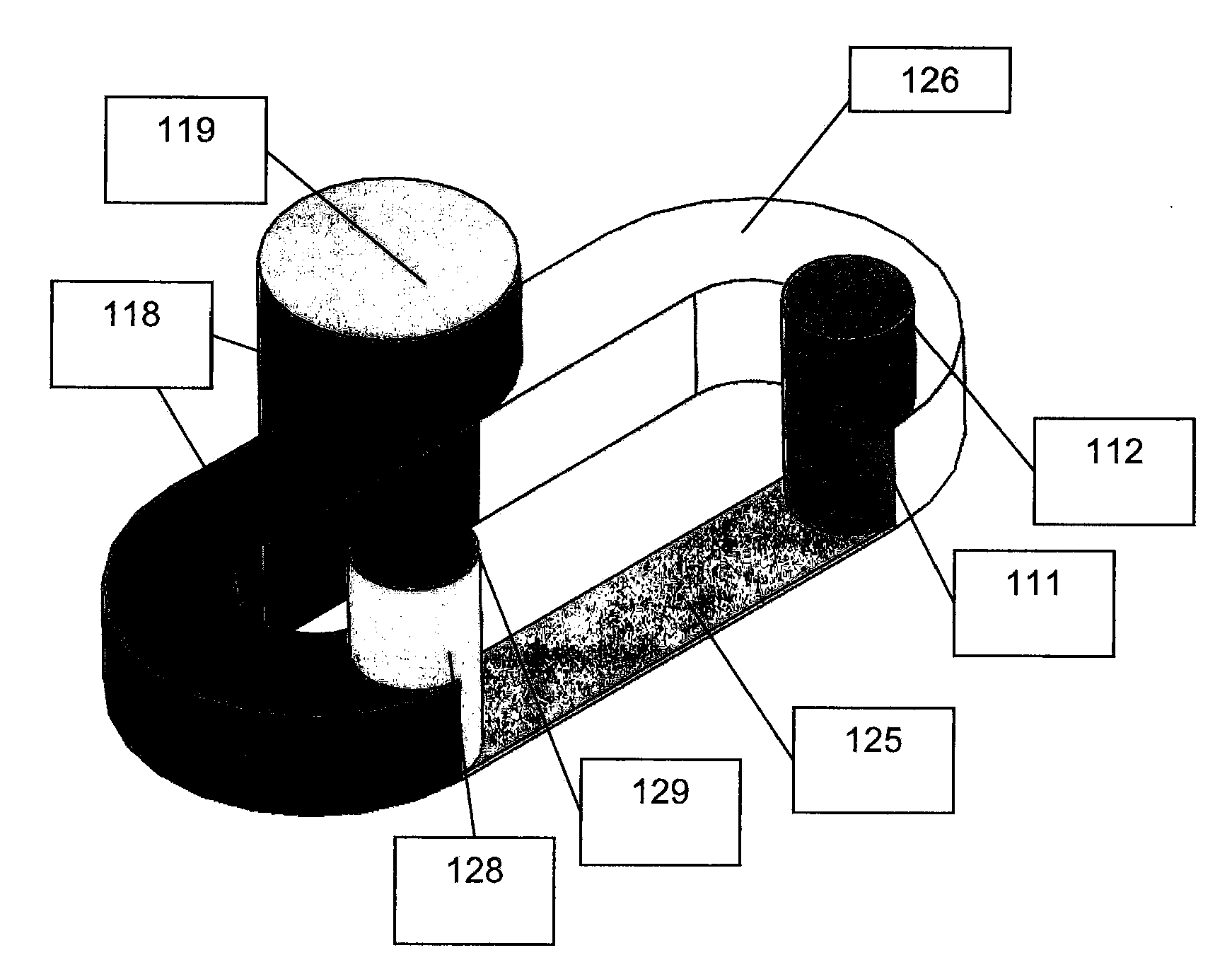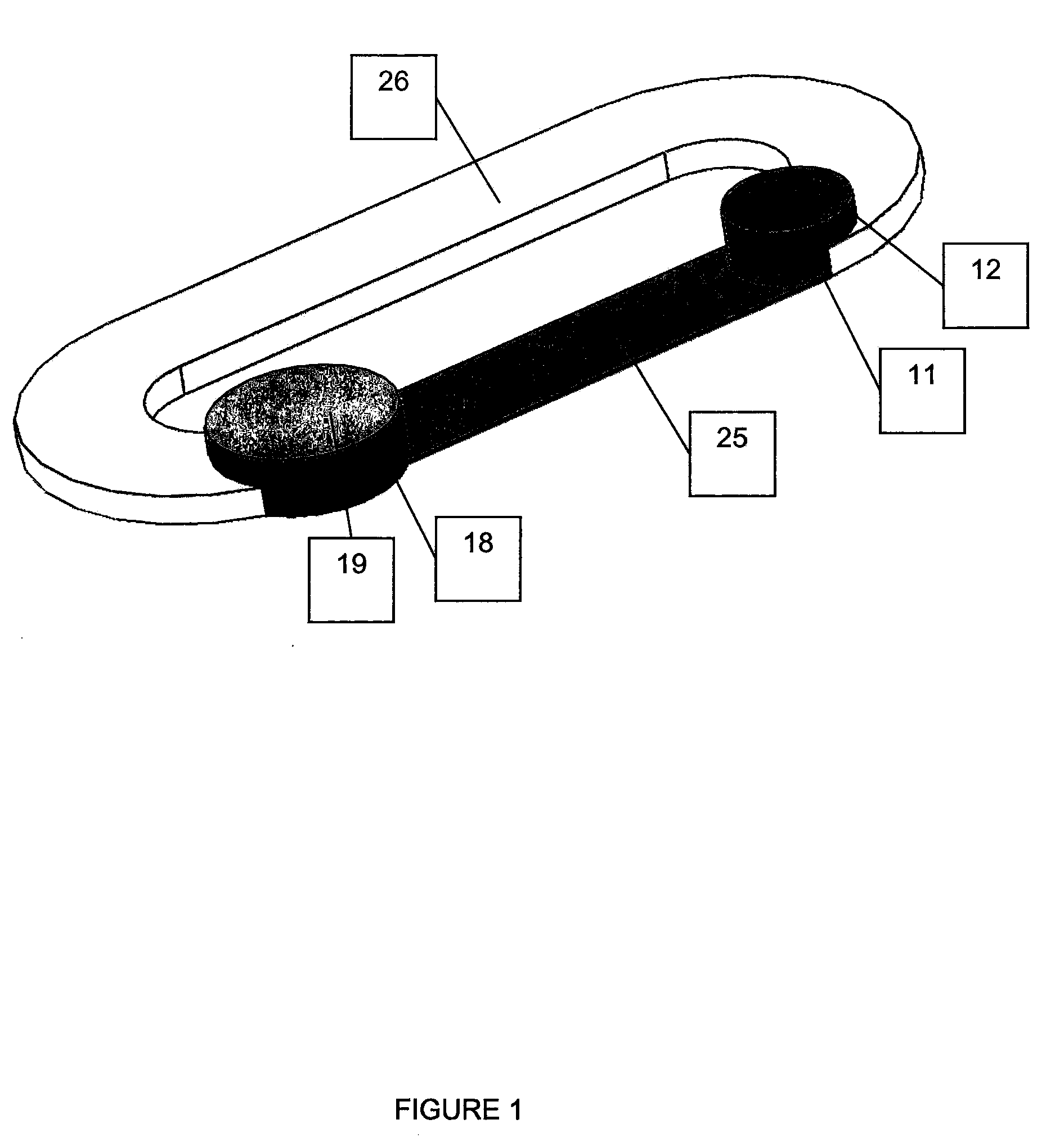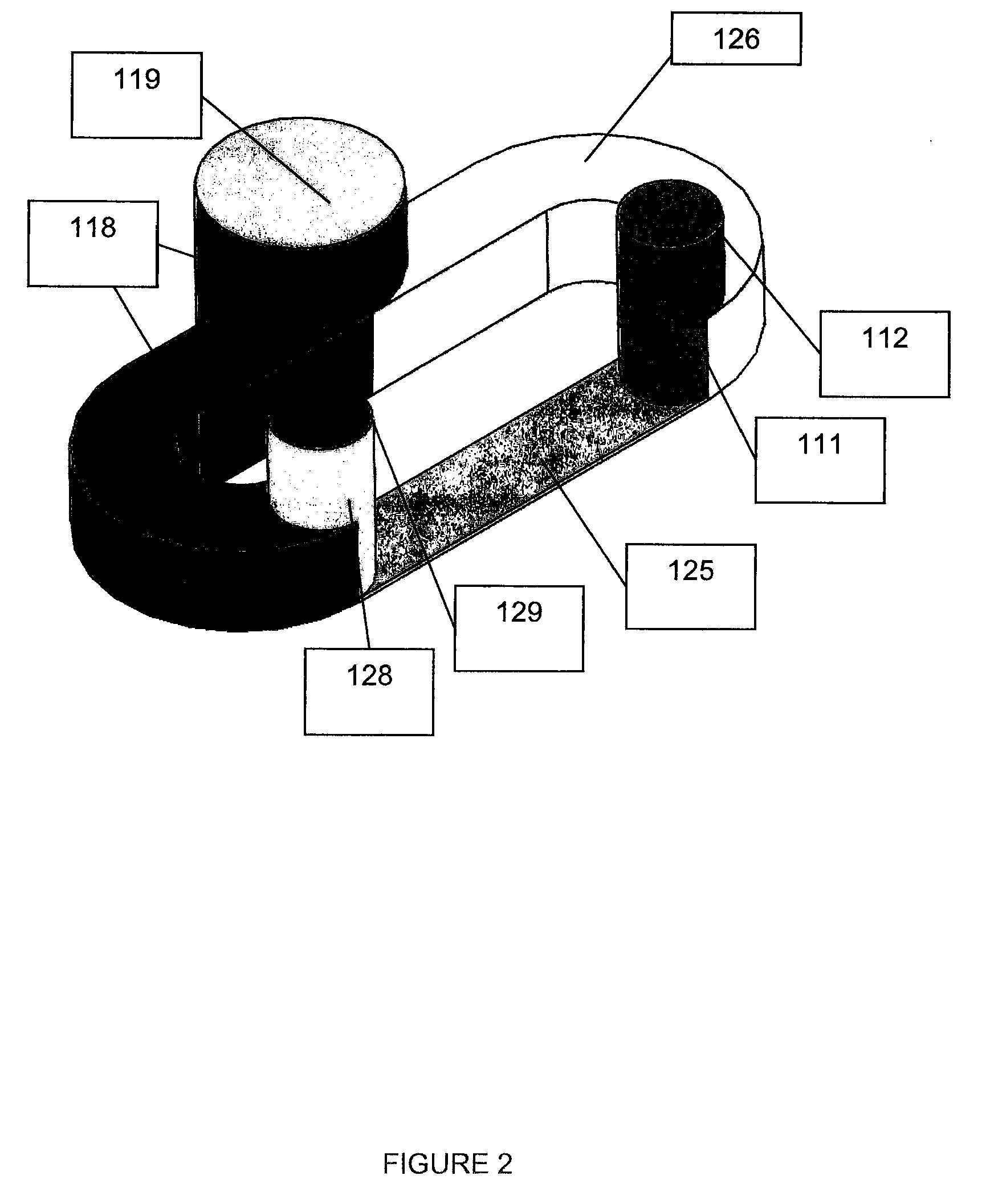[0193]One aspect of the invention includes a microfluidic gradient device having a source assembly adapted to contain a source liquid volume in the range of 25 pL to 15 μL defining a source assembly air / liquid interface having a source assembly radius of curvature comprising a source port having a source port area and source port perimeter in fluid communication with a source reservoir, a sink assembly adapted to contain a sink liquid volume in the range of 500 pL to 100 μL defining a sink assembly air / liquid interface having a sink assembly radius of curvature comprising a sink port having a sink port area and a sink port perimeter in fluid communication with a sink reservoir, a gradient channel adapted to contain a gradient fluid volume in the range of 500 fL, to 6 μL, the gradient channel having a gradient height, gradient width, gradient length, gradient transverse cross-sectional area, gradient flow resistance in the range of 1×108 to 1×1018 N-s-m−5, and, gradient contact angle, the gradient channel in fluid communication with the source reservoir and sink reservoir, and, a closed circuit channel adapted to contain a circuit liquid volume in the range of 50 pL to 400 μL, the closed circuit channel having a circuit height, circuit width, circuit length, circuit transverse cross-sectional area, circuit flow resistance in the range of 1×106 to 1×1015 N-s-m−5, and, circuit contact angle, the closed circuit channel in fluid communication with the source reservoir and sink reservoir, wherein the ratio (gradient flow resistance):(circuit flow resistance) is in the range of (10-10,000):1.
[0194]Another aspect of the invention includes a microfluidic gradient device having a source assembly adapted to contain a source liquid volume in the range of 25 pL to 15 μL defining a source assembly air / liquid interface having a source assembly radius of curvature comprising a source port having a source port area and source port perimeter in fluid communication with a source reservoir, a sink assembly adapted to contain a sink liquid volume in the range of 500 pL to 100 μL defining a sink assembly air / liquid interface having a sink assembly radius of curvature comprising a sink port having a sink port area and sink port perimeter in fluid communication with a sink reservoir, a cell addition assembly adapted to contain a cell addition assembly liquid volume defining a cell addition assembly air / liquid interface having a cell addition assembly radius of curvature comprising a cell addition port having a cell addition port area and a cell addition port perimeter in fluid communication with a cell addition reservoir, the cell addition reservoir in fluid communication with the sink reservoir, a gradient channel adapted to contain a gradient liquid volume in the range of 500 fL to 6 μL having a gradient height, gradient width, gradient length, gradient transverse cross-sectional area, gradient flow resistance in the range of 1×108 to 1×1018 N-s-m−5, and, gradient contact angle, the gradient channel in fluid communication with the source reservoir and sink reservoir, and, a closed circuit channel adapted to contain a circuit liquid volume in the range of 50 pL to 400 μL having a circuit height, circuit width, circuit length, circuit transverse cross-sectional area, circuit flow resistance in the range of 1×106 to 1×1015 N-s-m−5, and, circuit contact angle, the closed circuit channel in fluid communication with the source reservoir and sink reservoir, wherein the ratio (gradient flow resistance):(circuit flow resistance) is in the range of (10-10,000):1.
[0195]Another aspect of the invention includes a microfluidic gradient device having a source assembly adapted to contain a source liquid volume in the range of 25 pL to 15 pL defining a source assembly air / liquid interface having a source assembly radius of curvature comprising a source port having a source port area and source port perimeter in fluid communication with a source reservoir, a sink assembly adapted to contain a sink liquid volume in the range of 500 pL to 100 μL defining a sink assembly air / liquid interface having a sink assembly radius of curvature comprising a sink port having a sink port area and sink port perimeter in fluid communication with a sink reservoir, a gradient channel adapted to contain a gradient liquid volume in the range of 25 pL to 6 μL having a gradient height, gradient width, gradient length, gradient transverse cross-sectional area, gradient flow resistance in the range of 1×108 to 1×1018 N-s-m−5, and, gradient contact angle, the gradient channel in fluid communication with the source reservoir and sink reservoir, a cell addition assembly adapted to contain a cell addition assembly liquid volume defining a cell addition assembly air / liquid interface having a cell addition assembly radius of curvature comprising a cell addition port having a cell addition port area and a cell addition port perimeter in fluid communication with a cell addition reservoir, the cell addition reservoir in fluid communication with the gradient channel, and, a closed circuit channel adapted to contain a circuit liquid volume in the range of 50 pL to 400 μL having a circuit height, circuit width, circuit length, circuit transverse cross-sectional area, circuit flow resistance in the range of 1×106 to 1×1015 N-s-m−5, and, circuit contact angle, the closed circuit channel in fluid communication with the source reservoir and sink reservoir, wherein the ratio (gradient flow resistance):(circuit flow resistance) is in the range of (10-10,000):1.
[0196]Another aspect of the invention includes a microfluidic gradient device having a source assembly adapted to contain a source liquid volume in the range of 25 pL to 15 μL defining a source assembly air / liquid interface having a source assembly radius of curvature comprising a source port having a source port area and source port perimeter in fluid communication with a source reservoir, a sink assembly adapted to contain a sink liquid volume in the range of 500 pL to 100 μL defining a sink assembly air / liquid interface having a sink assembly radius of curvature comprising a sink port having a sink port area and sink port perimeter in fluid communication with a sink reservoir, a gradient channel adapted to contain a gradient liquid volume in the range of 500 μL to 6 μL having a gradient height, gradient width, gradient length, gradient transverse cross-sectional area, gradient flow resistance in the range of 1×108 to 1×1018 N-s-m−5, and, gradient contact angle, the gradient channel in fluid communication with the source reservoir and sink reservoir, a closed circuit channel adapted to contain a circuit liquid volume in the range of 50 pL to 400 μL having a circuit height, circuit width, circuit length, circuit transverse cross-sectional area, circuit flow resistance in the range of 1×106 to 1×1015 N-s-m−5, and, circuit contact angle, the closed circuit channel in fluid communication with the source reservoir and sink reservoir, and, a cell seeding assembly adapted to contain a cell seeding assembly liquid volume in the range of 30 pL to 65 μL defining a cell seeding assembly air / liquid interface having a cell seeding assembly radius of curvature comprising a cell addition port having a cell addition port area and a cell addition port perimeter in fluid communication with a cell addition reservoir in fluid communication with a cell addition channel in fluid communication with the gradient channel having a cell addition height, cell addition width, cell addition length, cell addition transverse cross-sectional area, and, cell addition flow resistance in the range of 5×106 to 6×1013 N-s-m−5, wherein the ratio (gradient flow resistance):(circuit flow resistance) is in the range of (10-10,000):1.
[0197]Another aspect of the invention includes a microfluidic gradient device having a source assembly adapted to contain a source liquid volume in the range of 75 pL to 110 μL defining a source assembly air / liquid interface having a source assembly radius of curvature comprising a source port having a source port area and source port perimeter in fluid communication with a source input reservoir, and, a source auxiliary channel in fluid communication with the source input reservoir and a source reservoir having an auxiliary height, auxiliary width, auxiliary length, auxiliary transverse cross-sectional area, auxiliary flow resistance in the range of 1×106 to 1×1015 N-s-m−5, and, auxiliary contact angle, a sink assembly adapted to contain a sink liquid volume in the range of 500 pL to 100 μL defining a sink assembly air / liquid interface having a sink assembly radius of curvature comprising a sink port having a sink port area and sink port perimeter in fluid communication with a sink reservoir, a gradient channel adapted to contain a gradient liquid volume in the range of 500 fL to 6 μL having a gradient height, gradient width, gradient length, gradient transverse cross-sectional area, gradient flow resistance in the range of 1×108 to 1×1018 N-s-m−5, and, gradient contact angle, the gradient channel in fluid communication with the source reservoir and sink reservoir, and, a closed circuit channel adapted to contain a circuit liquid volume in the range of 50 pL to 400 μL having a circuit height, circuit width, circuit length, circuit transverse cross-sectional area, circuit flow resistance in the range of 1×106 to 1×1015 N-s-m−5, and, circuit contact angle, the closed circuit channel in fluid communication with the source reservoir and sink reservoir, wherein the ratio (gradient flow resistance):(circuit flow resistance) is in the range of (10-10,000):1.
 Login to View More
Login to View More 


